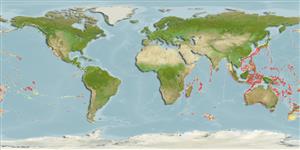>
Lophiiformes (Anglerfishes) >
Ogcocephalidae (Batfishes)
Etymology: Malthopsis: Greek, malthe, es = a marine fish of soft flesh (Ref. 45335); gigas: Name refers to the giant adult body size of the genus (Ref. 84006).
Environment: milieu / climate zone / depth range / distribution range
Ecologia
marino batidemersale; distribuzione batimetrica 210 - 650 m (Ref. 123774). Subtropical
Indo-Pacifc: Madagascar and Somalia to French Polynesia; north to Japan, south to New Zealand.
Size / Peso / Age
Maturity: Lm ? range ? - ? cm
Max length : 13.6 cm SL maschio/sesso non determinato; (Ref. 84006)
Short description
Morfologia | Morfometria
Raggi dorsali molli (totale): 5-6. This species differs from its congeners in having the following characters: relatively long and strong rostrum (5.2-11.5% SL, x = 8.6% SL); rostral spine directed forward and upward; body heavily covered with strong conical bucklers; numerous small and flat bucklers covering dorsal surface between principal bucklers; dorsal and anal fins relatively long, 17.6-29.5% SL and 17.4-24.2% SL, respectively; dorsal surface with black spots; anal fin when fully laid back extends beyond caudal fin base; largest adult body size (up to 136.4 mm) among its congeners 9Ref. 84006).
Life cycle and mating behavior
Maturità | Riproduzione | Deposizione | Uova | Fecundity | Larve
Ho, H.-C. and K.-T. Shao, 2010. A review of Malthopsis jordani Gilbert, 1905, with description of a new batfish from the Indo-Pacific Ocean (Lophiiformes: Ogcocephalidae). Bull. Natl. Mus. Nat. Sci., Ser. A, (Suppl. 4):9-19. (Ref. 84006)
IUCN Red List Status (Ref. 130435)
Threat to humans
Harmless
Human uses
Informazioni ulteriori
Nomi ComuniSinonimiMetabolismoPredatoriEcotossicologiaRiproduzioneMaturitàDeposizioneSpawning aggregationFecundityUovaEgg development
Age/SizeAccrescimentoLength-weightLength-lengthLength-frequenciesMorfometriaMorfologiaLarveDinamica popolazioni larvaliReclutamentoAbbondanzaBRUVS
BibliografiaAcquacolturaProfilo di acquacolturaVarietàGeneticaElectrophoresesEreditarietàMalattieElaborazioneNutrientsMass conversion
CollaboratoriImmaginiStamps, Coins Misc.SuoniCiguateraVelocitàModalità di nuotoArea branchialeOtolithsCervelliVista
Strumenti
Special reports
Download XML
Fonti Internet
Estimates based on models
Preferred temperature (Ref.
123201): 8.1 - 17.1, mean 11.8 °C (based on 274 cells).
Phylogenetic diversity index (Ref.
82804): PD
50 = 0.5001 [Uniqueness, from 0.5 = low to 2.0 = high].
Bayesian length-weight: a=0.01000 (0.00244 - 0.04107), b=3.04 (2.81 - 3.27), in cm total length, based on all LWR estimates for this body shape (Ref.
93245).
Trophic level (Ref.
69278): 3.3 ±0.6 se; based on size and trophs of closest relatives
Resilienza (Ref.
120179): Medio, tempo minimo di raddoppiamento della popolazione 1.4 - 4.4 anni (Preliminary K or Fecundity.).
Fishing Vulnerability (Ref.
59153): Low vulnerability (10 of 100).
